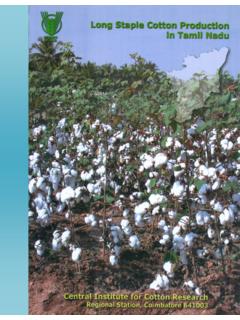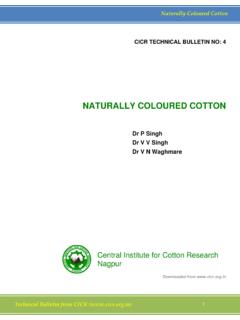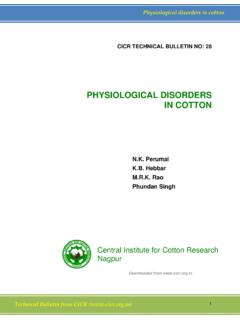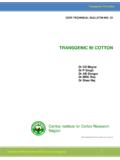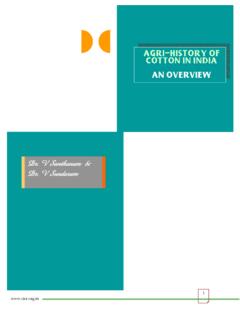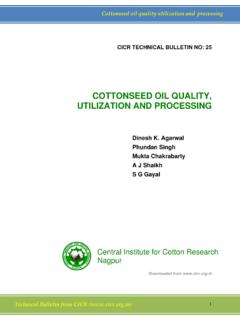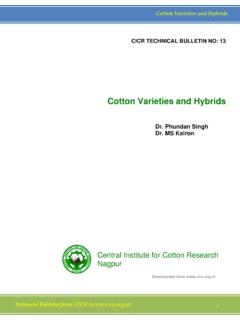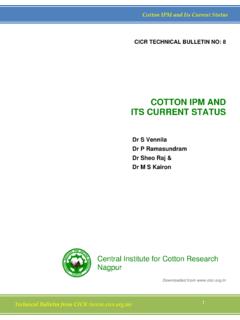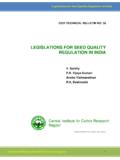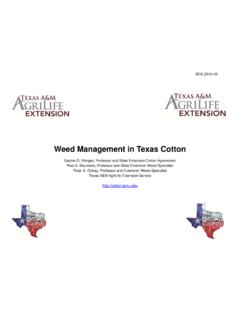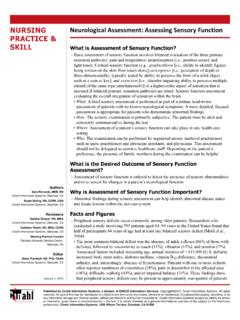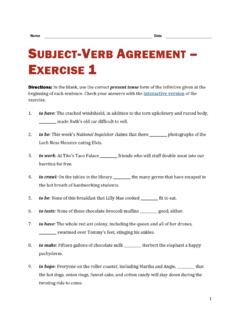Transcription of Approved Package of practices for Cotton: …
1 1 Approved Package of practices for cotton : Maharashtra State I. Major cropping system in the region (crop rotation / intercropping) A. Intercropping: i. cotton + Green gram / Black gram (1:1 row proportion) ii. cotton + Sorghum + pigeon Pea + Sorghum (6:1:2:1 row proportion) II. Crop season: Kharif (June to February) III. Land preparation: Rainfed: Ploughing once after three years Irrigated: Ploughing every year Harrowing: Two harrowing after Ploughing and third harrowing before sowing after receipt of monsoon rains to reduce the weed infestation IV.
2 Method of sowing: A. Drilling method: For straight varieties B. Dibbling method: For hybrids (wider spacing) V. Soil, Seed rate and spacing: Normal as well as paired row cropping pattern of sowing for cotton gave similar yields hence either planting pattern can be adopted. Spacing depending upon the hybrids / variety of cotton to be sown. For rainfed intra-hirsutum hybrids two plants per hill produced significantly higher kapas yield than one plant per hill. Sowing of deshi and American cotton to the direction of North-south or East-West was not found beneficial in increasing the yield of seed cotton under rainfed condition.
3 Situation Soil type Spacing Density (plant /ha) A) Irrigated cotton Heavy soil 150 x 90 cm 7,407 1. Hybrid Medium soil 120 x 90 cm 120 x 60 cm 9,259 13,888 Heavy soil 90 x 60 cm 18,518 2. Varity Medium soil 120 x 60 cm or 120 x 30 cm 13,888 27,777 B) Rainfed cotton Heavy soil 60 x 60 cm 27,777 Medium soil 60 x 30 cm 55,555 i) American varieties Medium soil 90 x 90 cm 12,345 Heavy soil 90 x 60 cm 18,518 ii) American hybrids Medium soil 60 x 60 cm 27,777 Heavy soil 60 x 15 cm 1,11,111 iii) Deshi varieties Medium soil 45 x cm 98,765 2 Sr.
4 Particular Seed rate (kgha-1) Spacing (cm) A G. hirsutum i PKV RAJAT 10-12 60 X 30 ii AKH-8828 10-12 60 X 30 iii AKH-081 15-20 60 X 15 iv DHY-286 15-20 60 X 30 B G. arboreum i AKA-5/AKA-7/AKA/8 12-15 60 X 15 ii AKA-8401 09-10 60 X 30 C Hybrids i PKV HY-2 AND 3 90 X 60 ii PKV HY-4 AND 5 60 X 60 IRRIGATED 120 X 90 D Arboreum hybrids i PKV DH-1 60 X 45 ii AKDH-5 60 X 45 VI. Fertilizer: cotton crop should be manured with FYM or compost at least once in 3 years at the rate of 12 to 15 tons/ha. The fertilizer dose of 100:50:50 (NPK) kg/ha for irrigated cotton ; 80 :40:40 (NPK) kg/ha for rainfed cotton hybrids and 50:25:25 NPK kg/ha both for desi and hirsutum varieties are recommended.
5 Nitrogen should be in two splits for rainfed cotton crop 50% at sowing time and 50% at square formation stage and three split for irrigated cotton i,e, 1/3rd at sowing time, 1/3rd at one month after sowing and remaining 1/3rd at 60 DAS. While whole P and K should be applied as basal dose for both rainfed and irrigated cotton . The application of basal dose of fertilizer to dibbled cotton crop should be given at the time of sowing by ring method 5 to 6 cm away from dibbled seed. Deley application of basal dose of fertilizers reduces the yield of seed cotton to the tune of 10 to 40% with in late duration period of 10 to 30 DAS.
6 Spraying of DAP at the rate of 2% at the time of flowering and boll development stage gave 10 to 20% higher seed cotton yield as well as avoid the redding of cotton . Seed treatment with azatobactor was found beneficial for cotton crop for reducing the nitrogen dose to the tune of 20 to 25 %. Sr. Particulars RDF NPK (kgha-1) Time of application Method of application A i Hybrids Irrigated 100:50:50 1/3rd N and full P2O5 and K2O as basal, 1/3rd N after 30 DAE and 1/3rd N after 60 DAE Ring method / Spot application ii Rainfed 50:25:25 1/2 N and full P2O5 and K2O as basal, 1/2 N after 30 DAE Ring method / Spot application B Improved varieties 50:25:0 1/2 N and full P2O5 as Broadcasting 3 of Hirsutum basal, 1/2 N after 30 DAE followed by hoeing C Improved varieties of arboreum 30:15.
7 0 1/2 N and full P2O5 as basal, 1/2 N after 30 DAE Broadcasting followed by hoeing D Arboreum hybrids 50:25:25 1/2 N and full P2O5 and K2O as basal, 1/2 N after 30 DAE Spot application / Broadcasting Application of chemical fertilizers should be as per soil test report. VII. Integrated Nutrient Management: A. Application of FYM / compost 5 t per hectare every year + 50 % RDF B. For Hirsutum varieties / hybrids apply 50 % RDF as basal and t /ha luceana lopping 30 and 40 days after sowing. This INM not only save fertilizer but improve soil fertility.
8 C. Application of 50 % RDF (25 + kg ha-1 N and P2O5) before sowing or glyricidia green foliage lopping at 30 DAE @ 5 t/ha is recommended to get higher seed cotton yield and net monitory returns with the added benefit of improving physico-chemical soil properties under rainfed condition. D. Application of FYM @ 5 t/ha along with low fertilizer dose of 25 + kg/ha N and P2O5 is recommended for cotton variety AKH-081 grown under shallow soil (less than 25 cm) to get maximum monetary benefit in rainfed condition.
9 E. For cotton crop ppm available iron content in soil and 281 ppm in youngest mature leaf at square initiation stage be considered as critical level for application of iron. F. Use of bio-fertilizers: a. Azotobactor @ 25 gm/kg seed b. PSB @ 20 gm/kg seed VIII. Water management: i. Source of irrigation: Well ii. Method of irrigation: a. Spot application for pre-monsoon cotton by crow bar method b. Drip irrigation for irrigated cotton c. Furrow irrigation to irrigated cotton d. Protective irrigation by alternate furrow at critical growth stages iii.
10 Irrigation scheduling: a. Peak flowering: If there is necessity b. Boll development: If there is necessity c. Stop irrigation after boll bursting iv. Intercultural operations: a. Three to four hoeing at an 15 to 20 days interval by bullock drawn implements for removing weeds, aeration and to check evaporation b. At last hoeing open the furrow between two rows of cotton by tying the ropes to hoe for conservation of rains 4 Water management for rainfed cotton : Sowing of cotton crop on contour ridges resulted in to good crop growth and optimum plant population both in high rainfall and low rainfall situation under rainfed condtion.
